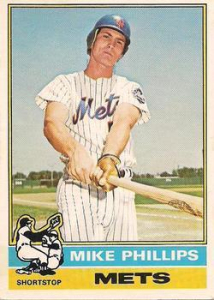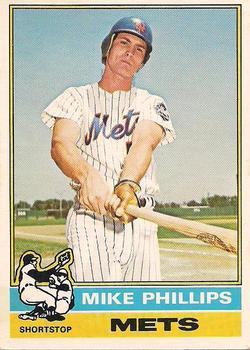June 25, 1976: Mets’ Mike Phillips breaks out of slump to hit for the cycle
 Two weeks before the 1976 All-Star Game, the New York Mets were in a slump. They had opened the season with 18 wins in their first 27 games, occupying first place briefly in late April and early May. A 15-28 slide from May 9 through June 22, however, had dropped them to a distant third in the National League East, 15 games behind the first-place Philadelphia Phillies.
Two weeks before the 1976 All-Star Game, the New York Mets were in a slump. They had opened the season with 18 wins in their first 27 games, occupying first place briefly in late April and early May. A 15-28 slide from May 9 through June 22, however, had dropped them to a distant third in the National League East, 15 games behind the first-place Philadelphia Phillies.
The Mets’ offense had struggled during that stretch, getting shut out nine times and scoring two or fewer runs in 22 games. A 5-4 win over the St. Louis Cardinals on June 23 was their most runs in a game in nearly two weeks.
The Mets’ next stop was a three-game series with the Chicago Cubs at Wrigley Field, beginning on June 25. The Cubs were also struggling. Although they had snapped a four-game losing streak with two consecutive walk-off victories over the Pittsburgh Pirates, they entered the series in fourth place, three games behind the Mets.
According to Augie Borgi of the New York Daily News, the perfect remedy for New York to cure a slump consisted of “Wrigley Field and Cub pitching.”1
Right-hander Ray Burris started the Friday afternoon series opener for the Cubs. He had been Chicago’s Opening Night pitcher in St. Louis, but his season to this point had not been effective. He had lost nine of his 12 decisions and came into the contest with an unimpressive 4.52 ERA. Southpaw Jon Matlack started for the visiting Mets. The 1972 NL Rookie of the Year and 1975 All-Star Game MVP2 was again enjoying a solid season, sporting an 8-2 record with a 2.80 ERA. He had pitched three shutouts and nine complete games so far.
The weather forecast for the Windy City called for partly sunny skies with “winds westerly at 10 to 20 miles an hour.”3 This meant that the winds would be gusting from home plate down the right-field line. Great news for New York’s lineup, which was heavy with left-handed batters.
Mike Phillips, one of those lefties, was at shortstop, filling in for the injured Bud Harrelson.4 He had been claimed by the Mets on waivers from the San Francisco Giants in early May 1975, specifically to replace Harrelson but more generally as a utility infielder.
Phillips entered the Cubs’ series hitless in his previous 21 at-bats and batting .207 with only two extra-base hits all season. He led off the game by striking out looking, pushing his streak to 0-for-22. Felix Millán then lined a triple into left field, but he was stranded as Burris retired the next two New York hitters.
Chicago’s Rick Monday “started Matlack’s day with a homer into the green seats in center field.”5 The Cubs had a quick 1-0 lead, but it didn’t last. With one out in the top of the third, Phillips drove a double down the right-field line. On the next play, he tried to take third on Millán’s grounder to shortstop Dave Rosello, who threw to third baseman Bill Madlock in time to get the sliding Phillips.
The Mets continued to rally with Millán on first and two outs. John Milner singled and Dave Kingman smashed his 24th home run of the season for a 3-1 lead. It was Kingman’s fourth home run in six games against the Cubs, and the ball landed in the very last row of the left-field seats.
Chicago answered in its next two times up. In the bottom of the third, singles by Rosello, José Cardenal and Madlock resulted in a run. An inning later, George Mitterwald and Manny Trillo started the frame with back-to-back singles. Matlack retired Steve Swisher and Rosello on infield grounders. Burris followed with another grounder, but first baseman Ed Kranepool misplayed it for an error, and Swisher scored the game-tying run.
The Mets had overcome Phillips’ baserunning mistake to score three times in the third, but poor baserunning—lackadaisical, rather than overaggressive—again plagued them in the fifth.
Phillips led off by launching a “wind-blown drive”6 that struck the top of the right-field wall and bounced back toward the Mets bullpen. He stood in the batter’s box watching the flight of the ball and didn’t start running until after the ball struck the ivy, so he “made third with a triple instead of an inside-the-park homer.”7 It was Phillips’ first triple of the season.
After Phillips held at third on Millán’s groundout, Milner popped the ball down the right-field line, and, instead of running, he too stood at home plate and watched second baseman Trillo chase the ball. Trillo dropped it, and Phillips scored easily.
Milner trotted without much purpose down to first base safely; first-year Mets manager Joe Frazier replaced him with pinch-runner Bruce Boisclair. Kingman then bounced into an inning-ending double play. The Mets were back on top at 4-3, but they had a controversy.
According to the New York Times, Milner had been troubled by a pulled groin since the early part of the season. After the game, Frazier told reporters, “If he has got a bad leg, I don’t want him playing.”8
The skipper claimed it was not a disciplinary decision, but Milner, who had been criticized before this game for “half-hearted play,”9 threw his batting helmet after being removed from the game. He then “stormed up the runway to the clubhouse.”10 Obviously, Milner didn’t agree with Frazier, since Phillips had not been replaced for not running all-out earlier in the inning, or for his poor baserunning decision in the third.
The score remained 4-3 until the seventh. Matlack singled with one out and scored when Phillips clouted his first home run of the season, a blast into the right-field bleachers11 that pushed the New York lead to 6-3.
Millán grounded a single into center, and Cubs manager Jim Marshall made a pitching change, bringing in rookie Bruce Sutter to relieve Burris. It was Sutter’s 17th appearance of the season. Millán advanced to second on a groundout by Boisclair. Kingman notched his fourth run batted in of the game with a single to left, and New York’s lead grew to 7-3. Kranepool doubled to put two runners in scoring position, and Sutter’s time on the mound was over. Paul Reuschel came in to record the final out of the inning.
Matlack had retired seven in a row until Rosello led off the bottom of the seventh with a single. Then, with two outs, Cardenal hit an RBI double to right, giving Chicago its fourth run of the game.
With Mike Garman now pitching for Chicago, Wayne Garrett singled to start the eighth inning. By the time Phillips settled into the batter’s box, after Jerry Grote and Matlack made outs, he had more extra-base hits (3) in this game than he had made all season. Phillips pulled a grounder toward first for an infield single. Although Millán grounded out, leaving two runners on base, Phillips had become the third Mets player to hit for the cycle.12
Matlack finished the complete game by retiring the final seven batters. The Mets had pounded out 14 hits (half of them by Phillips and Kranepool) and scored seven runs, their highest output since June 4, when Kingman hit three homers in a win over the Los Angeles Dodgers.
Phillips was also the third player to hit for the cycle in 1976. Coincidentally, he was the second player to accomplish the feat against the Cubs that year.13
The next day, the Mets continued their winning ways, cruising to a 10-2 victory. Milner and Kingman homered. So did Phillips, who also hit a round-tripper in the series finale, on June 27, giving him three homers for the weekend series and the season.
The Mets swept the three-game series, outscoring Chicago 30-9. They were off on a 10-game winning streak through July 4, when the Cubs—who had lost nine in a row by then—beat them in the second game of a doubleheader at Shea Stadium on America’s Bicentennial. The Mets finished 1976 in third place in the NL East with an 86-76 record, their seventh winning season in eight years.14
Augie Borgi’s recipe to break a slump proved to be profound.
Acknowledgments
This essay was fact-checked by Bruce Slutsky and copy-edited by Len Levin.
Author’s Note
With his low batting average (.207) and slugging percentage (.228), New York’s Mike Phillips defied the expectations for a batter to hit for the cycle. Coming into this game, his 35th of the season, only two of his 19 hits in 1976 had gone for extra bases (both doubles). In his 11-season major-league career, Phillips managed only 81 extra-base hits, including 11 home runs, in 712 games, with a slugging percentage of just .314.
His specific sequence of the four necessary hits (double, triple, home run and then single, or 2-3-4-1) is the rarest of the 24 permutations in hitting for the cycle, occurring just seven times in history.15 Phillips was only the second batter in history to get his four different hits in this order, following the Washington Senators’ Joe Cronin, who did so on September 2, 1929.
Sources
In addition to the sources mentioned in the Notes, the author consulted Baseball-Reference.com, MLB.com, Retrosheet.org, and SABR.org.
https://www.baseball-reference.com/boxes/CHN/CHN197606250.shtml
https://www.retrosheet.org/boxesetc/1976/B06250CHN1976.htm
Notes
1 Augie Borgi, “Phillips’ Cycle, Kong’s 24th Help Matlack to No. 9, 7-4,” New York Daily News, June 26, 1976: 29.
2 Matlack was named to the National League’s All-Star Team in three consecutive seasons, 1974-1976.
3 “Weather,” Chicago Tribune, June 25, 1976: 1.
4 According to Harrelson’s SABR biography, from 1972 through 1975 he missed 300 games with injuries to his hands, sternum, back, and knee. See Eric Aron, “Bud Harrelson,” SABR Biography Project, found online at https://sabr.org/bioproj/person/Bud-Harrelson/. Accessed January 2023.
5 Borgi.
6 Borgi.
7 Borgi.
8 Paul L. Montgomery, “Milner Benched as Mets Triumph, 7-4,” New York Times, June 26, 1976: 28.
9 Montgomery.
10 Montgomery.
11 Borgi. Baseball-Reference.com reports that the homer was deep to center field.
12 Phillips followed Jim Hickman (August 7, 1963, against the St. Louis Cardinals) and Tommie Agee (July 6, 1970, also against the Cardinals). Since Phillips’ feat, eight more players have hit for the cycle in Mets franchise history as of the beginning of the 2023 season. For the full list, see https://www.mlb.com/news/players-who-hit-for-the-cycle-c265552018.
13 The six players to hit for the cycle in 1976 were Tim Foli (Montreal Expos, April 21-22 against the Cubs); Larry Hisle (Minnesota Twins, June 4 against the Baltimore Orioles); Mike Phillips; Lyman Bostock (Minnesota Twins, July 24 against the Chicago White Sox); César Cedeño (Houston Astros, August 9 against the St. Louis Cardinals); and Mike Hegan (Milwaukee Brewers, September 3 against the Detroit Tigers).
14 The Cubs finished 1976 at 75-87, fourth place in the NL East, 11 games behind the third-place Mets.
15 Of the 339 cycles in major-league history as of the end of the 2022 season, sequences were known for 321. Many newspapers from the nineteenth century list types of hits in the box scores, but they sometimes lack the detailed play-by-play, which is necessary to provide the order in which the batter made those hits. The 2-3-4-1 sequence has occurred just seven times, or in only 2.18 percent of all of the known cycle sequences.
Additional Stats
New York Mets 7
Chicago Cubs 4
Wrigley Field
Chicago, IL
Box Score + PBP:
Corrections? Additions?
If you can help us improve this game story, contact us.


